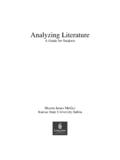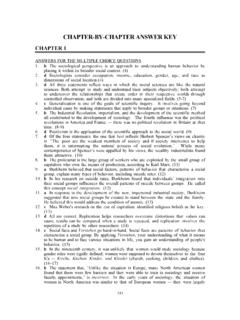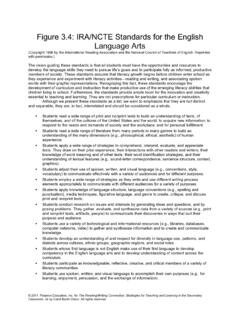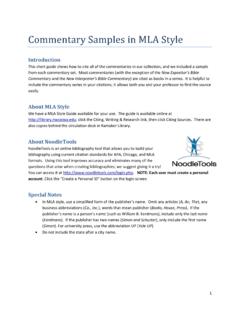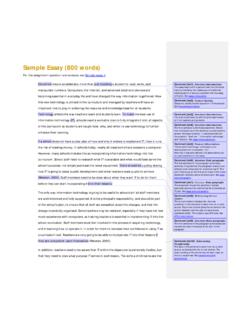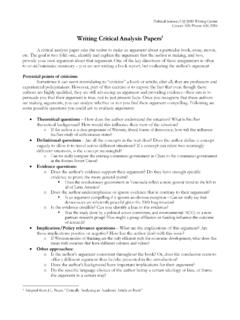Transcription of How to Structure Analytical/Expository Writing
1 158 How to StructureAnalytical/ expository WritingFrom Olson (2003). The reading/ Writing connection: Strategies for teaching and learningin the secondary classroom (companion website). New York: Allyn & of ContentsThe Structure of Analytical/Expository Writing ..1 Sample Paper: "The Tragic Life and Death of Willy Loman" .. 2 Organizing and Planning a Composition ..5 Finding a Focus: Clustering and Freewriting .. 5 Considering Your 6 Should You Use I in Your Paper?.. 6 Determining an Appropriate Tone .. 6 Formulating a Writing .. 8 Writing Your Introduction .. of .. a Question .. Interior ..14 Sharing Your a Hook ..15 Comparing Two Versions of Your Introduction ..15 Developing the Main Body of Your the Main Body ..17 Distinguishing Between Summary and commentary ..17 Quoting From the , Not Telling.
2 19 Using Figurative Language ..20 Unifying Devices ..21 Repetition of Key Words and Phrases ..21 Consistency of Tone ..21 Transition and Signal Your Main Points of an Essay ..23 Asking a Question ..23 Drawing a Final Conclusion ..24 Coming Full Circle ..24 Aha ..24 Proposing a Solution ..24 Criteria for an Effective Analytical/Expository ..26 Style ..26 Form .. and Peer I Really Mean ..27 Deleting ..28 Rearranging ..28 Rearranging for for for Style ..28 Sentence Combining .. Importance of Drafting and Structure of Analytical/Expository WritingAnalytical/ expository compositions are usually designed to explain, analyze, interpret,speculate, evaluate, persuade, or reflect. But, regardless of what they are about or theirintent, Analytical/Expository compositions usually have a three-part structureconsisting of an introduction, main body and a conclusion.
3 The introduction orients thereader to the writer s purpose and focus as well as indicates something about what thereader can expect to find in the remainder of the essay. Most introductions contain athesis statement which communicates the point the writer intends to make -- althoughsome writers may choose to let the reader infer what their thesis is or to include it at theend of the composition rather than at the beginning. In the main body, the writerexplores and develops the controlling idea or ideas presented in the introduction pointby point by providing examples, details, and facts, by giving reasons, and by relatingincidents. The conclusion reminds the reader of the essay s main point bysummarizing, coming full circle, exploring the significance of something, asking aquestion, offering new insights, order to give you a sense of what the Structure of an analytical /expositorycomposition looks like, the following essay, The Tragic Life and Death of WillyLoman by a community college student is included on the next page.
4 The students inthis freshman composition class were asked to read Arthur Miller s definition of a tragichero in his essay Tragedy and the Common Man, and then, applying Miller sdefinition to his play, Death of a Salesman, write a persuasive essay arguing whether themain character, Willy Loman, does or does not qualify as a tragic hero1162 IntroductionThis sentenceties in withthe titleReferenceto Miller sdefinitionof thetragic heroPart 1 ofthe MainBody--Phase 1 The Tragic Life and Death of Willy LomanEvery person on earth is a precious resource--one of a kind andspecial. Any object known to man which is the only one of itskind ispriceless. Once lost or tarnished, it disappears forever; and that is atrue tragedy. The same sense of tragedy and loss hold truefor the lifeand death of Willy Loman, the main character in Arthur Miller sDeath of a Salesman.
5 Willy s whole existence was spent behind afortress of lies and illusions that mounted until the misconceptionswere too high to control and the walls of his fortress came tumblingdown. His tragic life seems to have three phases. In the first phase,Willy misrepresents himself because of his shortcomings or, as ArthurMiller identifies it in his essay Tragedy and the Common Man, his tragic flaw. In the second phase, Willy fears being torn away fromhis illusions of himself and the philosophy he lives by--so much sothat in his final phase he is willing to die for the same beliefs thatproved misleading and damaging not only in his own life but in thatof his sons. In essence, he puts a price tag on his own the time Willy s sons were born, he must have felt hewas a failure.
6 This tragic flaw, as Miller called it, hounded him to thepoint where he contrived false ideas about himself to convey toothers. His popularity in New England is something he constantlybrags about: I can park my car on the street and the cops watch it asif it were their own. Like most fathers, Willy wanted his sons togrow up reflecting his ideas and beliefs. This would be their key tosuccess. Unfortunately, Willy didn t genuinely believe in himself andoften doubted the ideas he professed. He projected counterfeitideologies in order to raise his feelings of self-worth as well as tobenefit his idea of being well-liked is the pivotal point in Willy s plan forsuccess. He feels a terrible shortcoming in this department; as aresult, he overemphasizes the importance of his possessing such aquality.
7 He demonstrates his blind faith in popularity when he says, And when I bring you fellas up, there ll be open sesame for all of us, cause one thing boys, I have friends. These types of illusions mountand develop as Willy enters phase two--living with his lies in fear ofbeing torn away from his offersher owndefinition oftragedyOutline ofessay sstructureThis sentencewill tie inwith theconclusionTransition toPhase 22163 Part 3 ofMain Body--Final PhaseAll of Willy s illusions have been created at this point but he now hasthe problem of juggling them so as not to destroy his fantasy he works in New England, Willy imposes a large distancebetween his work and his family. This allows him to stretch the truthabout his successes in New England with the peace of mind that hecannot be found out and character of Charley plays a central role in this phase of Willy slife.
8 Charley is not an advocate of Willy s theories and yet he is a is why Willy resents him. Willy feels that being well-liked is crucialbut Charley is only liked. He also pays no great attention to his son asWilly does to his; and yet Bernard becomes successful while Biff andHappy are both somewhat losers. Charley is a thorn in Willy s side. It isdoubly humiliating that Willy must look to Charley for a loan at the endof each month to pretend to Linda that he has been making commissionon his sales. This segment of Willy s life leads into the most tragic part ofhis in the final phase of Willy s life, the woods are burning. Herealizes that time is running out on him and he feels compelled to makehis mark--to proclaim to the world that Willy Loman existed. This is veryimportant to him--something concrete and lasting.
9 His attempt at acarrot garden is really a symbolic gesture indicating Willy s desire tomake something grow and compares his life to his older brother, Ben, in this phase. Benwalked into the jungle of life poor and exited a rich man; he beat thejungle. Willy feels he has lost the battle to the jungle and now must exitthe only way left open to him--suicide. In Tragedy and the CommonMan, Miller says that the tragic hero is ready to lay down his life, forhis beliefs. In the end, Willy Loman is such a man. He strongly believesthat his sons--especially Biff--are well-liked and clings to the dream thatwith a little money they could make something of themselves. Therefore,with his illusions still strongly implanted in his mind, Willy takes the carand his illusions to his 2 ofMainBody--Phase 23164 ConclusionReturn toMiller s criteriaThesisStatement IIAccording to Miller s definition, the character of Willy Loman isby all means a tragic hero.
10 His life was a play in which he acted therole of someone he would like to have been but was not tragic flaw, or the shortcoming he felt about himself, made himdevelop false ideas and philosophies. These concepts, in turn, werepassed on to his sons who were hurt by them. Willy clung to hisdreams, refused to be torn away from them and, eventually, carriedthem all the way to his death. While Miller may see Willy s suicideas heroic, I see only the tragic dimensions of his actions. I say it wasa tragic death because Willy compromised a priceless life for atwenty thousand dollarinsurance ISummaryof paperReturn towriter sdefinition oftragedy4165 Organizing and Planning a CompositionIt is not enough to know what you want to say in an Analytical/Expository also have to carefully consider how you want to say it.

